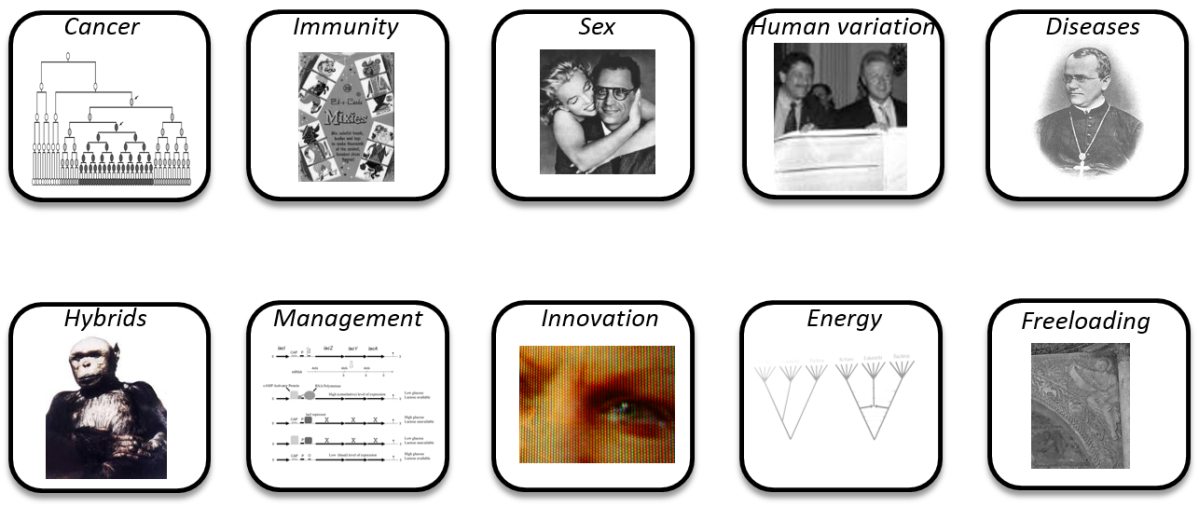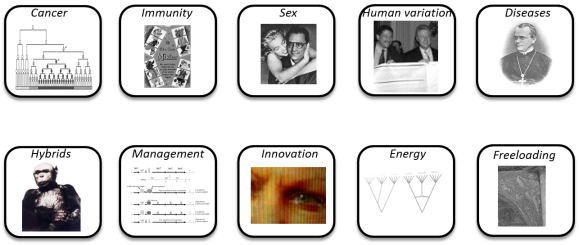“If Darwin had been able to observe cancer cells through a microscope, he would have had just as much evidence for his theory as he obtained by studying complete organisms.” The Society of Genes.

[the only figure from Darwin’s ‘Origin of Species’]
Ernst Mayr, one of the 20th century’s leading evolutionary biologists, nicely pointed out that Darwin’s theory of evolution is actually multiple theories: 1. Change occurs (species are not fixed), 2. Common descent (all species are related), 3. Evolution occurs gradually, and 4. Natural selection (One Long Argument, 1991). Jerry Coyne, in his wonderful book ‘Why Evolution is True’, also included ‘Genetic drift’ as another agent of evolutionary change.
These principles were first sketched out to describe the evolution of species, but they can all equally be applied to the evolution of cancer in an organism’s population of cells:
- Change occurs: The genome is not fixed – different cells in your body have different genomes.
- Common descent: All human cells in a body are linked by a cell lineage, and each can give rise to a tumor or another cell
- Gradualism: Cancer takes years to develop because multiple steps are required
- Natural selection: Cells better at proliferation dominate.
- Genetic drift: Many changes in cancer karyotypes are not associated with the cancerous properties

[Image from Bob Weinberg’s Biology of Cancer]
Here’s a snippet from a relevant part of Chapter 1 of our book: The cells of our bodies accumulate changes to their genes from cell generation to cell generation (principle 1: change occurs). Each of us is a colony of cells, all of which descended from a single cell with a single set of genes—the fertilized egg. In cancer, the gene set controlling one renegade cell lineage starts to follow its own agenda, abandoning its cooperation with the rest of the body. This sublineage of cells can be considered a new “species” relative to the noncancerous cells (principle 2: common descent). But no single mutation can transform a perfectly healthy cell into a cancerous one—instead, the renegade genomes accumulate changes slowly, one by one (principle 3: evolution occurs gradually). The proportion of the body taken up by a given cell lineage can change due to heritable mutations—pre-cancerous cells that divide faster outcompete their well-behaved neighbors (principle 4: natural selection). Not all genomic changes are relevant to the function or the proliferation of the cell, so some changes may become common in a population by chance alone (principle 5: chance changes exist).
This aspect of cancer shows us that evolution is not something that only happened in the past. It is happening everywhere, all of the time, even within the confines of your own body. Because of that, it is inevitable that we get cancer unless we die of another cause first. However, even if we do get cancer, it is not inevitable that we must die of it – curbing the growth of cancers is one of the hardest challenges in biology, but ongoing research keeps finding new ways of helping our immune systems to succeed in this task.








 Even though genomes have been sequenced for over two decades, I find that genomics is still not properly taught in most universities. In particular, Evolution is generally not awarded its proper place in the understanding of genomes.
Even though genomes have been sequenced for over two decades, I find that genomics is still not properly taught in most universities. In particular, Evolution is generally not awarded its proper place in the understanding of genomes.


